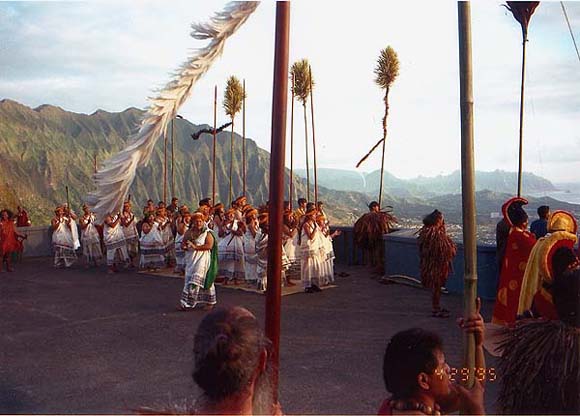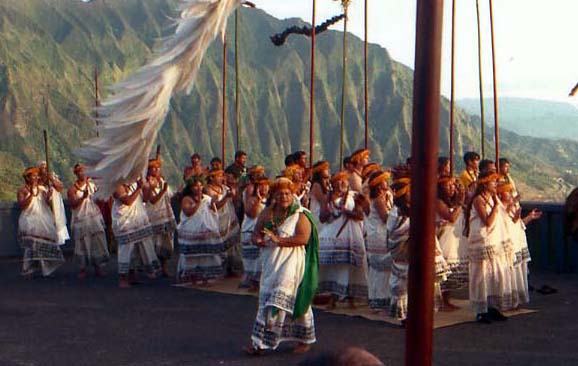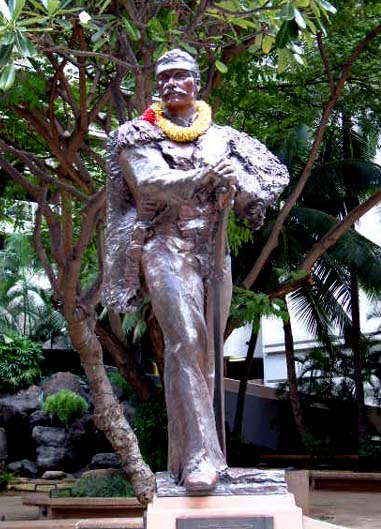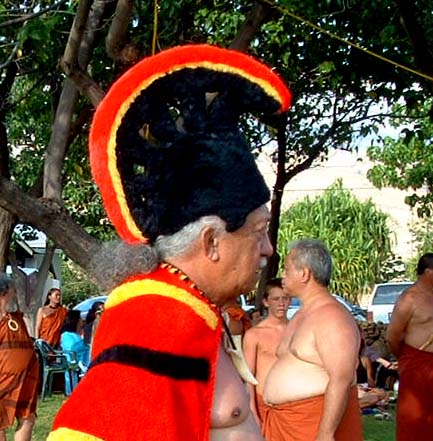Ceremony at the Nu‘uanu Pali
|
|
Calling people together to participate in this event was itself a journey. Mel recalls, "One night I was way up past Kahuku, one of the owners up there set up, he called the community together, so I drove all the way upside there, and I told them what this march was about. Some people accept it, some families get resentment about the loss of their loved ones up here. "That night I was up there, this guy came in and I was shocked. Here was him bad-mouthing Kamehameha, and he was going off, so I thought, just let him vent himself, he needs to get it out of there. After he sat down, I had the transcript of one of the people that was with Kamehameha, he was writing all in Hawaiian, and somebody went transcribe ‘em, and I had a copy with me. I told him, “brother, maybe this is meant for you.” So I gave it to him, and he looked at ‘em, and oh, he started to tear, you know. "And I stood up, I told him, 'maybe there is another reason I came here tonight. Maybe it's for you. Because for me, my father's family from this island (Ko'olau side) was in that battle. I know they were up here. And on the other side, I have my mother's family from Kohala.' "And then when I got through, he looked at me and he said, 'Oh, thank you. Maybe it’s about time. All this kaumaha was handed down our generations. Maybe it’s about time we join forces. This is a time for us, in our hearts, to forget about the past.' I said, 'We have to come together so we can move on.' I came back that night and I thought, 'if I went there and saved one guy for doing all this walking, that was worth it'."
|
||
|
||
Preparations: “The City & County permit guys were, ‘this is going to cost you one arm and one leg!’ They were figuring out, one cop getting paid, x number of hours, times the number of cops they going get, they said, ‘I don’t know if you’re going to get enough money.’ I said, ‘don’t worry about that, we’re going to take care of that.’ And then every motorcycle cop went volunteer for that night. This was something , they wanted to participate, because within the Police Department there is a Hawaiian contingency, and plenty police officers that really wanted to see this kind of thing happen. "Down Waikiki, everybody showed up. And Bishop Estate provided all the buses from Kamehameha Schools to be at the Pali. At the end, I had these buses pick up everybody up here and take them back down to Waikiki. "We stared at 11:30 p.m., at the bandstand in Waikiki. Kapi‘olani Park is where we met. I had people monitoring from the outside, everybody who needs water, first aid, stuff like that. To keep the thing really spiritual, everybody had to get one kihei. No yelling, that kind of stuff. Sort of a kapu. In the prayer, it was said that as Hawaiians, the kapu is to do this thing in love, that we are doing this for the love of the commemorating of the battle. But the whole thing was that the story of this battle is our story, people talk about how bloody it was, but after that, we had a nation."
|
||
|
||
Kumu Keola Lake and his halau.
|
"We started out with over 1000 people. It was a long line. Our first ceremony was at Kuhio Beach for the beach ceremony, where Kamehameha came by water. We had a water ceremony, where both families were represented in the water. I made arrangements for the canoe club that operates over there, but I don’t know what happened, they weren’t there. "Nearby in the same area are four major ancient pohaku (stones) that represent the ancient kahuna. Their names are Kapaemahu, Kahaloa, Kapuni and Kinohi. We paused to give ho'okupu at this site. "After that everybody congregated, and then we started to walk up Kalakaua avenue. We stopped briefly at Kalakaua’s statue. I went go take ho‘okupu, because he was on the way, so we stopped there. Then we turned on Kapi‘olani and went down the left side, facing the town. The director of transportation, after we were leaving, he told me, you know what Mel, you go anyplace you like. Just tell the sergeant of the police force. “Na Koa of Pu‘u Kohola came, honoring this event in traditional style, the dress code of that time. So they had the long spears, everybody was dressed just like 200 years ago. In the front line and the side line was all the Na Koa’s. It was like stepping back in time. We made about 125 torches from bamboo, stuff them with wick and kerosene. I had some torches we were supposed to take and stand up the Pali, and everyone was just grabbing torches, they went carry them all the way up there. "So we came down Kalakaua, we turned up Kapi‘olani, I told them, I like to go on the left side, and stay on the left side. So they shut off all the road on the left side, and we went right through to the Kamehameha statue. We got there about 20 to 2 in the morning. All the Royal Orders--Kamehameha, Ka‘ahumanu--were there waiting for us, all the Hawaiian organizations were present. The warriors from Pu‘u Kohola were there with long spears, and all their long spears went down at Kamehameha’s statue, and we started to chant, a prayer of unity. And when the chanting started, all the long spears went down on the ground by Kamehameha, for that honor. Talk about chicken skin! It was a real time of coming together, that essence of forgiving was there."
|
||
|
||
Robert Wilcox statue.
|
"After that ceremony was done, we moved on King Street and we stopped at Wilcox and gave some ho‘okupu to the Wilcox Statue there on Fort Street Mall. Then we went up on Bethel Street rather than Nu‘uanu, we went up Bethel and crossed Beretania and up Nu‘uanu. Some of the street people were sleeping on the bench. These two guys leapt up, they were screaming, they didn’t know where they were! Here came warriors with malos on, spears in their hands! "We stopped briefly at Mauna ‘Ala, and Auntie Namahana was just inside the gate. I went inside, go see her, she was glad to see this happening. We were joined by other people up there that came late. And then we went up to Queen Emma’s park, where we rested. I guess we stayed there until about 3:30. And then we moved on to the summit, up the old Pali Road and back onto the Pali Highway. The safety factor was there because of the cones and the police officers. I had to buy insurance to pay for that, and then asked everybody to help pay for it, they paid two dollars each. “The kind of honor when you pay tribute to the people of kahiko: the honor is the malo. We made kihei available just for the cost of the kihei. Then we had special t-shirts made for those that was monitoring from the outside. "When we reached the summit, the Na Koa surrounded us so that we could change from our kihei to our long feather capes and put on our mahiole. The war god, Ku, was raised at the summit. It was a moving experience for everyone to see Ku." "The morning was really crisp, you couldn’t ask for anything better for that ceremony. It just came together. For me, it was something that was really needed--as a people we need to understand our past, and in a way that was honoring those that had fallen on both sides with chanting, prayer, and ho‘okupu. Ho‘okupu was given, the full measure is one ka’au. We told everybody that, and everyone understood: you bring ho‘okupu, bring forty. If you bring bananas, make sure you got 40 bananas hanging out of there. If it’s heavy, think of the ones that died. If the spear becomes heavy, think of the sacrifice of that night. And the kahili, whatever you carry. When you think about those that did the full measure of that sacrifice, your load becomes light."
|
||
|
||
|
“Ho‘okupu is giving, it’s a way of expressing of your sadness, or your love for the person, but the whole essence of the ho‘okupu is you come there with your ho‘okupu to make something grow. The ho‘okupu is to make growth, to make positive growth. So for me, it is not a political thing, a gift-giving. …. If you’re doing it for unification, you want to see unification of our people once more—that growth. Or especially with Lili’uokalani, the cry was to stand the nation. In the case of Kauikeaouli, if you read is speech, he’s talking about standing up his nation once more, he’s looking for the growth of his people. So when you’re bring things for whoever, you know where they’re coming from. And so the cry goes on. "For me it was something that I needed to do. I used to go up there late at night, that time early morning with brothers, they come in from the islands, those whose loved ones that were part of that battle that was lost, or that died; just go up there and just get on with the elements. It changes, cleanses you when you do that, especially up there, knowing the elements up there are part of you, your ancestors. There is that honor in the ancestors. So all of these has evolved in the cleansing, of oneself. "Because you look back at what Kamehameha did after the battle, and then you get a sense of why this man is great. He put the auwai back in Nu‘uanu valley, started planting, planting yams on the road, made sure the extra men he brought here got food in this ahupua‘a. Then he went from there along the island of O‘ahu, working on the auwai, planting taro. You know he was known as the warrior, people were kind of scared, but after, they see him not only talk, he’d put his hands in the ground. "So for me, it comes full circle on Kaniakapupu. It’s coming from one to the other. I don’t look at myself for fame or anything, I get it done and walk away from it. It all has been a rewarding experience, went all the way back to my grandfather. But I have a bigger call today, and that’s Kaniakapupu."
"Each year since, on the last Saturday of April, we have a dawn ceremony at the Pali summit to honor the warriors on both sides. It is sponsored by Na Papa Kanaka o Pu‘u Kohola Heiau."
|
||
|
||
|
|||||
|
|||||






Replies